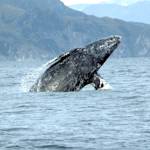Ganges River dolphin
2023 CE • Southern Asia
Ganges river dolphins once thrived throughout rivers of Nepal, India, and Bangladesh. "But the species is extinct from most of its early distribution ranges. The Ganges river dolphin can only live in freshwater and is essentially blind. They hunt by emitting ultrasonic sounds, which bounces off of fish and other prey, enabling them to “see” an image in their mind. They are frequently found alone or in small groups, and generally a mother and calf travel together . . . The Ganges river dolphin is important because it is a reliable indicator of the health of the entire river ecosystem . . . The habitat of the Ganges river dolphin is within one of the most densely populated areas of the world. Ganges river dolphins and people both favor areas of the river where fish are plentiful and the water current is slower. This has led to fewer fish for people and more dolphins dying as a result of accidentally being caught in fishing nets, also known as bycatch. The Ganges river dolphin is still hunted for meat and oil, which are both used medicinally. The oil is also used to attract catfish in net fishery . . . Each year, 9,000 tons of pesticides and 6 million tons of fertilizers are used in the vicinity of the river. High levels of pollution can directly kill prey species and dolphins, and completely destroy their habitat. As the top predator, river dolphins have been known to have high levels of persistent toxic chemicals in their bodies, which is likely to adversely affect their health."
"Dolphins and Porpoises: Ganges River Dolphin," World Wildlife Fund.
Image: Kukil Gogoi, CC BY-SA 4.0, via Wikimedia Commons


Learn about Maya Lin’s fifth and final memorial: a multi-platform science based artwork that presents an ecological history of our world - past, present, and future.

Discover ecological histories and stories of former abundance, loss, and recovery on the map of memory.

Learn how we can reduce our emissions and protect and restore species and habitats – around the world.

See how art can help us rethink the problems we face, and give us hope that each one of us can make a difference.

Help make a global memorial something personal and close to home. Share your stories of the natural world.


